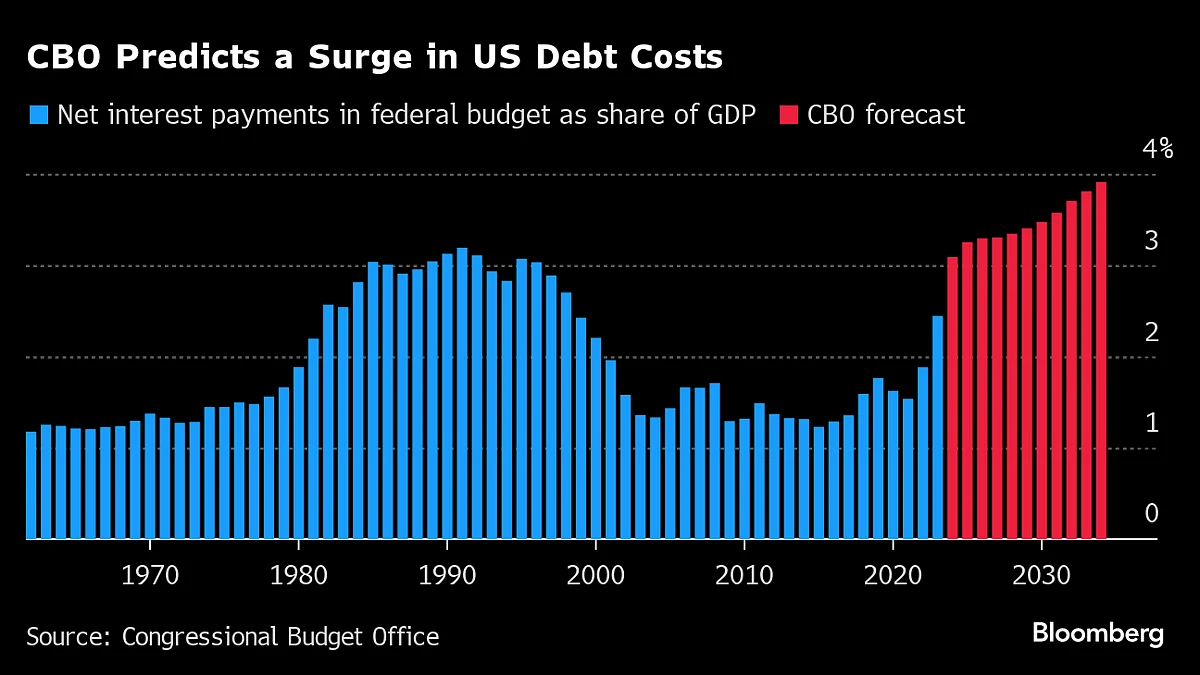CBO Warns 2025 Debt Interest Costs To Exceed World War II Levels
Net interest payments will climb to 3.1% of gross domestic product next year, the highest level in records going back to 1940, CBO said.

(Bloomberg) -- The cost to service the US government’s burgeoning debt load will hit a record high next year and then keep on climbing, the Congressional Budget Office warned on Wednesday.
Net interest payments will climb to 3.1% of gross domestic product next year, the highest level in records going back to 1940, and then go on to hit 3.9% in 2034, the CBO said in its latest outlook for the federal budget.
“Net interest costs are a major contributor to the deficit, and their growth is equal to about three-quarters of the increase in the deficit from 2024 to 2034,” CBO Director Phillip Swagel said in a statement.

That mounting cost may fuel concerns about the pace of federal borrowing. Federal Reserve Chair Jerome Powell said last week that “it’s probably time, or past time” for politicians to work on getting the government “back on a sustainable fiscal path.”
Treasury Secretary Janet Yellen, when pressed Tuesday in a House hearing about whether she’s concerned about the country’s borrowing capacity, said the Biden administration is preparing a budget for the next fiscal year that “will contain proposals to make sure we are in a fiscally sustainable path.”
Near Term
US debt held by the public is expected to reach $45.7 trillion, or 114% of GDP by 2033, according to the CBO’s latest forecasts. That’s actually down from the 118% projection for 2033 released a year ago.
But the nonpartisan arm of the US legislature also forecasts the average rate of interest the government pays on its debt will rise to 3.4% over the next 10 years, from the 3% predicted last year.
Listen to Big Take DC Podcast: America’s ‘Debt Spiral’ Nears a Critical Threshold
“Interest costs have more than doubled in just the past three years, rising to more than $2 billion per day this year,” Michael A. Peterson, head of the Peter G. Peterson Foundation, a budget watchdog, said in a statement. “By next year, we’ll spend more on interest than on defense and nearly all other national priorities.”
Mandatory spending was another big driver of deficits in the CBO outlook. Medicare spending is expected to grow to 4.2% of GDP in 2034 from 3.1% in 2023, and Social Security outlays increase to 5.9%, from 5% last year.
Speaker’s Comment
Republican House Speaker Mike Johnson in a statement Wednesday ascribed ballooning federal debt levels to “a spending problem, not a revenue problem.” The GOP-led House and the Democratic-controlled Senate have failed so far to pass a budget for the remainder of the 2024 fiscal year amid differences over spending levels and priorities.
Wednesday’s CBO forecasts show the budget deficit reaching $1.58 trillion this year — down from $1.68 trillion 2023 — but swelling over time to $2.56 trillion by 2034.
The slight improvement in the near-term outlook is little comfort to those worried about the government’s mounting borrowing requirements. The CBO projections assume that current law will remain in place, and don’t account for political pressures that in the past have led Congress to abandon spending caps or cut taxes. This regularly led to overly rosy deficit projections.
One particular assumption looks already under severe strain: that individual tax cuts included in former President Donald Trump’s 2017 Tax Cuts and Jobs Act will expire, as scheduled, at the end of 2025. That assumption boosts revenues from 2026 in the CBO’s projections.
But some Republicans, including Trump, have already vowed to make the cuts permanent. Biden has said he would extend the cuts for those earning less than $400,000 a year, but would match that with new revenue.
--With assistance from Rich Miller, Erik Wasson and Ben Holland.
(Updates with comments from CBO director Swagel)
More stories like this are available on bloomberg.com
©2024 Bloomberg L.P.